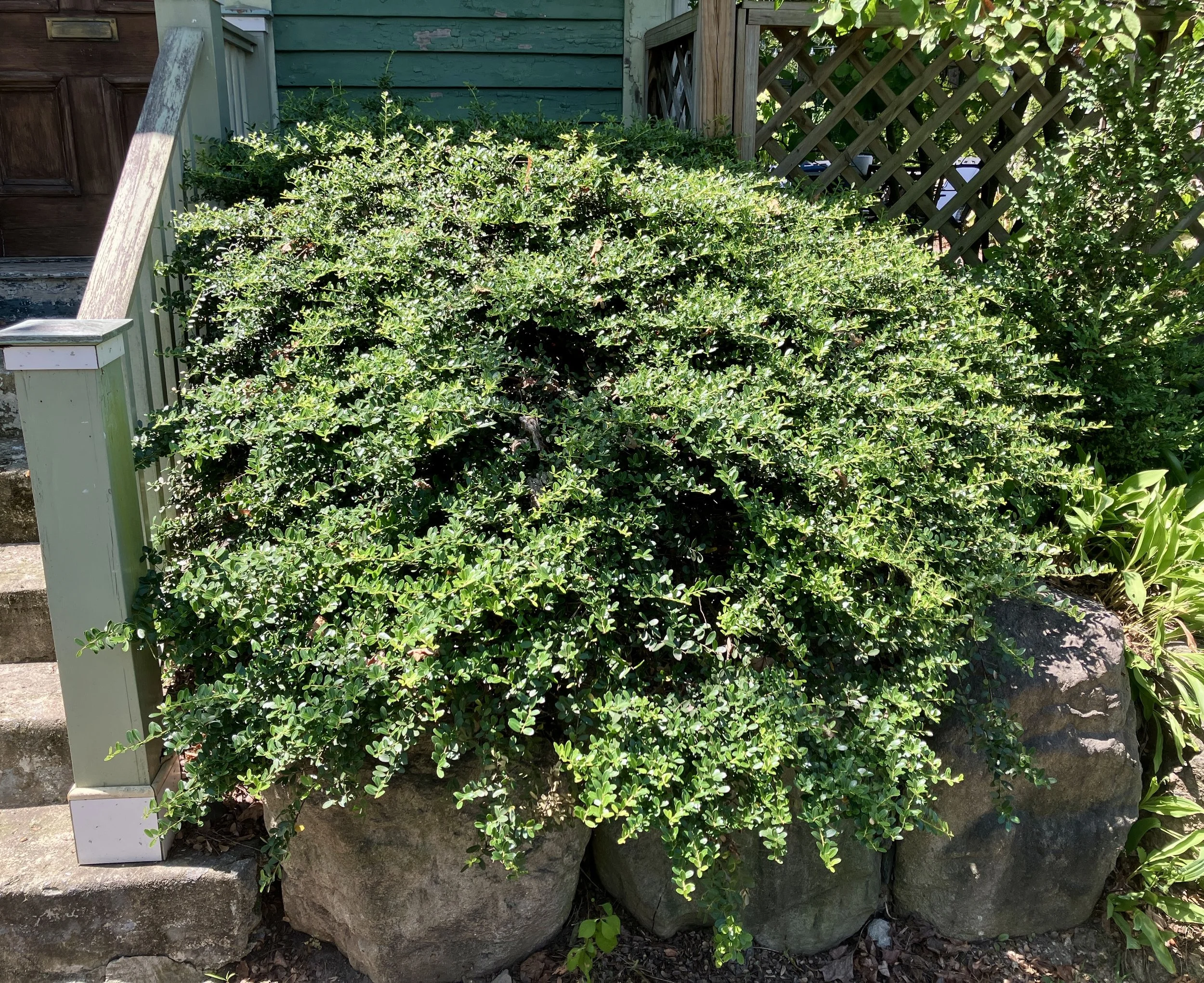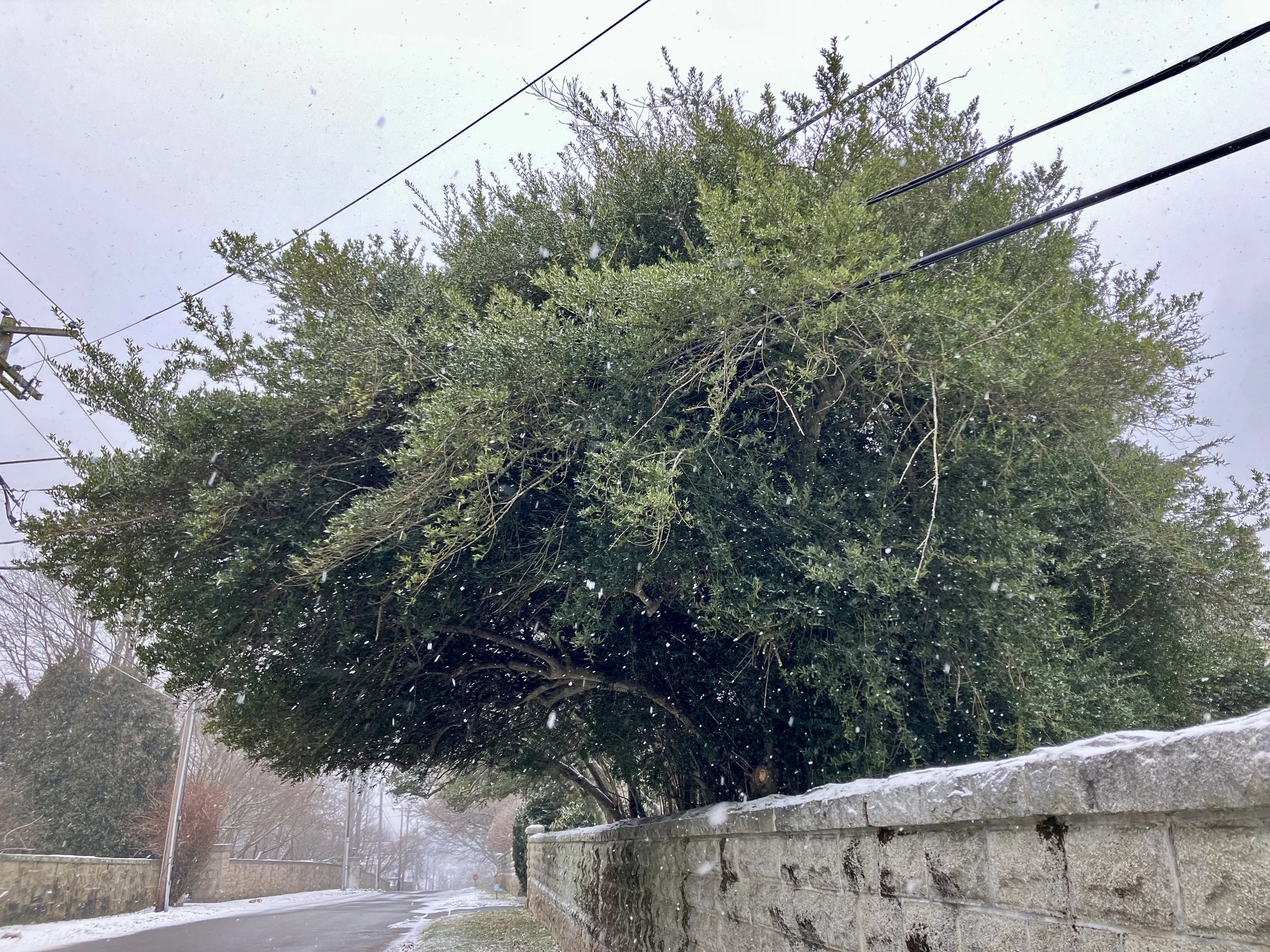Newport’s Horticultural History: Heller’s Japanese Holly
A great mistake I made during my time teaching landscape plants at the University of Rhode Island in 2023, was trying to pass off a named variety as the species when introducing a plant to the students. During the holly unit, I brought the class over to a pair of flourishing dwarf Japanese hollies (Ilex crenata ‘Helleri’) and declared that they were the Asian native Ilex crenata in its purest form. Of course, I knew the plants were a common cultivar frequently used in landscape plantings, but I was unaware of any species Japanese holly on campus and was forced to improvise. My plan was to cover the basic morphological features, then run away quickly. This decision would prove to be a mistake, as the majority of students began to question and then suspiciously accept that the distinct habit was the hollies’ natural form. “Is it always dome shaped?” “Why is it so dense?” I’m not sure what I responded with, but it wasn’t very convincing, and we hastily moved along to the next plant. Maybe a week later, when I found the species, I apologized to the group and took them back over to see ‘Helleri’ and correct my error by teaching them the true item.
A very old and large Japanese boxleaf holly, mingling with the power lines on Webster Street.
A bird planted seedling of I. crenata growing in Ballard Park along Hazard Road.
I remember learning Japanese Holly, sometimes called the Japanese boxleaf holly, as a student enrolled at URI. Starting out, I would mistake its identity for boxwood (Buxus sp.) with the leaves being quite similar, but I learned to separate them by the differing bud arrangements. Boxwood is oppositely arranged, and boxleaf holly has leaves held on alternating sides of the stem. Years later when I came to Newport, I would see I. crenata in all kinds of landscape situations, like the narrow ‘Sky pencil’ in a container, or the good doer ‘Hetzii’ as a specimen shrub in dappled shade. Typically described as a small to medium sized evergreen shrub, old plants growing on historic properties throughout Aquidneck Island have achieved tree status, measuring over 20 feet tall and wide. The species is quite prosperous in Newport, and bird planted seedlings can be seen growing in wild areas, including Ballard Park. These relatively harmless invaders are somewhat variable in their characteristics, but are always dense, rounded shrubs with small, dark green leaves. Although termed the Japanese boxleaf holly, the species is native throughout much of eastern Asia, from the Himalayas to the Philippines, north to Siberia. It is in Japan, however, where the plant’s remarkable variability in size and shape is best observed.
‘Helleri’ holly in the snow outside the main entrance to the Blithewold Mansion in Bristol, RI.
l. crenata ‘Helleri’ used as a low hedge in a Newport garden.
Grown from the Atlantic to the Pacific, ‘Helleri’ can be purchased at nurseries near and far, and is frequently encountered in Rhode Island landscapes. In 2015, the Holly Society of America named ‘Helleri’ the Holly of the Year, quite the honor considering the sheer number of named holly varieties floating about. The late holly expert Fred Galle said ‘Helleri’ was the standard of all dwarf I. crenata types in his 1997 volume, Hollies: The Genus Ilex. I personally like ‘Helleri’ for its formal dome shape, staying compact while also spreading with horizontal or slightly downward arching stems, leaves tilted upward. Makes a great plant for the rock garden, along the foundation, as a low hedge or in a container. Ultimate size probably equates to about 4 or 5 feet tall with close to double the spread. Interestingly, this form is female, described as being slow to flower or fruit, but I have seen older specimens with reasonable fruit set. It was also in Galle’s book that I read that ‘Helleri’ was introduced in the late 1930s by a J. Heller of Newport Nurseries…I had to read that part twice.
Developing fruits on a large ‘Helleri’ Individual
The beautiful evergreen foliage of ‘Helleri’, with light green new growth
Despite my existing interest in Rhode Island’s horticultural history, the name J. Heller and Newport Nurseries were completely new to me. After a few google searches, I couldn’t get a first name for this mysterious character, with additional online sources also listing them as J. Heller. I was not aware of a historical Newport Nurseries – wouldn’t it have come up in the conservations I’ve had with local nurserymen? Additional google searches yielded no information to infer that Newport Nurseries had existed on Aquidneck Island. Could the name honor another Newport? There are several scattered across this country and the world. Some initial calls for information from older professionals were also without luck, although a prominent local nurseryman did confirm the few available bits of information as being the story he’d been told. This gave me great confidence that ‘Helleri’ was a Newporter, and I needed to dive deeper.
A breakthrough came when I finally decided to insert a first name for Heller in my online searches. The logical choice was my own, Joseph, which I figured was probably as common a name 100 plus years ago as it is today. This search led me to a digitized version of the 1939 Journal of the Arnold Arboretum, with one of the articles, authored by German horticulturist Alfred Redher, describing new plants growing in the arboretum’s collections. One of these plants was ‘Helleri’, which at that time was listed as forma, f. helleri. Redher describes this new holly as having a low growing, dense habit and small, elliptical leaves. To give context for size, he mentions a man named Mr. E. Morell, who had 8 sizeable plants 18 inches in diameter in his Peacedale, RI garden around the time of writing. One could infer some of the first cuttings propagated were probably given to Morell – could these plants still be extant? Most Importantly, Redher confirmed that Newport Nurseries was located in a certain coastal Rhode Island town, and that J. Heller is in fact Joseph Heller, the manager of the business. According to Rehder, the plant was discovered by Mr. Heller in 1925, growing amongst a group of I. crenata seedlings. Three nurseries are listed as having ‘Helleri’ available for sale during the time of publication. It’s cool to see the plant was already embraced by growers in the 1930s.
Rehder, Alfred. 1939 New Species, Varieties and Combinations from the Collections of the Arnold Arboretum. 1939 Journal of the Arnold Arboretum. Boston, MA.
Equipped with a full name, I contacted the Newport Historical Society in hopes of learning more about Joseph Heller’s life as a nurseryman in Newport. Thanks to his obituary being in their collection, I was given a glimpse into who he was. As it turns out, Mr. Heller was born in beautiful Lucerne, Switzerland, where he was probably trained in horticulture. According to the short description of his life, Mr. Heller arrived in the United States in the early 1900s, and began working at Newport nurseries in 1907, a time in which Mr. Fred W. Smythe and Mr. (Albert) Wadley were the owners of the business. After Mr. Smythe’s passing, Mr. Heller became the general manager of the nursery, while Mrs. Smythe maintained ownership. Through additional research in old directories, a friend with interest in local history was able to conclude for me that Joseph Heller was the Manager/superintendent of the Nursery from 1920 until his untimely passing in 1941. He was married, had two children, and was a member of the still active Rhode Island Nurseryman’s Association.
Joesph Heller Obituary - May 7th, 1941. Newport Mercury. The collections of The Newport Historical Society.
In these old directories, Newport Nurseries Inc. is listed as being located on Vernon Avenue in Middletown, naming Frederick W. Smythe as the landowner. Finally using a paperbound resource, an atlas of Aquidneck Island published in 1921 at the Newport Historical Society, I was able to confirm that the nursery spanned from Miantonomi Avenue to Vernon Ave, between Fenner Ave and Boulevard, where Gold’s Auto Recycling is today. The adjacent parcel to the east, which today contains four 100-foot Quonset greenhouses, has been owned by the Vanicek family of Rhode Island Nurseries since that time. Another trusty resource for accessing historical landscapes, digitized aerial photographs of the entire state of Rhode Island in 1939, clearly shows a bustling nursery with rows of cultivated stock one year after a devastating hurricane. Also in 1939, Newport Nurseries receives a new location in the public listing, on Chase’s Road in Middletown. Aerial photograph confirms a sprawling nursery at this address, one of greater size than the Vernon location. It can be assumed that Newport Nurseries owner Smythe was expanding the business to more acreage.
Atlas of Newport, Middletown, Jamestown, & Portsmouth. Sanborn Map Company 1921. The collections of the Newport Historical Society.
The greenhouses on Vernon Ave, owned by Rhode Island Nurseries.
There is little doubt Newport Nurseries owner Frederick W. Smythe was very prominent in the early 1900s horticulture scene in this section of the country. Born in Chicago in 1870, Smythe is described as a well-known landscape architect and decorator, famous for his landscape design projects and interior decorations that included the Belmont racetrack on Long Island, John D. Rockefeller’s estate in Pocono Hills, NY, and for Eleanor Elkins Widener at the Neoclassical mansion “Miramar“ here in Newport. Smythe, in partnership with Albert Wadley, operated a florist storefront in the casino building on Bellevue Avenue; Smyth also owned a florist shop at the Waldorf Astoria Hotel on the famous Madison Avenue in Manhattan. He is described in his obituary has having several real estate interests, which included not only nurseries in Middletown (including Newport Nurseries), but also in New York State as well, where Smythe was a resident. With such great influence in the nursery and landscaping industry, it is very possible Smythe promoted ‘Helleri’ and exchanged the holly with other growers in this region. This influence would explain the cultivars long run of popularity in the nursery trade.
‘Helleri’ in five gallon containers at a local wholesale nursery, where it sells very well.
When comparing ‘Helleri’ to other Japanese holly cultivars in the Manual of Woody Landscape Plants 6th Edition, Micheal Dirr writes “(‘Helleri’) is one of the most widely planted cultivars, many better forms now available but ‘Helleri’ has name recognition”. It could be argued there are better Ilex crenata cultivars than Joseph Heller’s selection, but there is no arguing it’s a valuable and loveable dwarf broadleaf evergreen, filling a great many roles in gardens around the world. Through an exciting dive into Newport’s horticultural past, we now know the story behind the latinized name so often recognized at the garden center or nursery. Joseph Heller can get some of the name recognition his great introduction so often receives.
Two Japansese boxleaf holly cultivars planted next to each other, with ‘Helleri’ on the left and ‘Hoogendoorn’ on the right. Pruning has been done over the years.
The author pruning a large Japanese boxleaf holly hedge.
Joe Verstandig — Living Collections Manager
A special thank you to Harry Eudenbach, Morgan Palmer, Ingrid Peters, and Bert Lippincott
Bibliography:
Rehder, Alfred. 1939 New Species, Varieties and Combinations from the Collections of the Arnold Arboretum. 1939 Journal of the Arnold Arboretum. Boston, MA
Dirr, Micheal A. 2008. Manual of Woody Landscape Plants. 6th ED. Stipes, Champaign IL
Galle, Fred C. 1997. Hollies: The Genus Ilex. Timber Press. Portland OR.
Holly of the Year 2015. © 2025. Holly Society of America. hollysociety.org
Ilex crenata ‘Helleri’. Missouri Botanical Garden Plant Finder. missouribotanicalgarden.org
Obituaries: Frederick W. Smythe, Albert Wadley, Joseph Heller. Newport Historical Society Archives.














